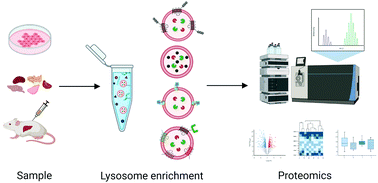A proteomic view on lysosomes†
Abstract
Lysosomes are the main degradative organelles of almost all eukaryotic cells. They fulfil a crucial function in cellular homeostasis, and impairments in lysosomal function are connected to a continuously increasing number of pathological conditions. In recent years, lysosomes are furthermore emerging as control centers of cellular metabolism, and major regulators of cellular signaling were shown to be activated at the lysosomal surface. To date, >300 proteins were demonstrated to be located in/at the lysosome, and the lysosomal proteome and interactome is constantly growing. For the identification of these proteins, and their involvement in cellular mechanisms or disease progression, mass spectrometry (MS)-based proteomics has proven its worth in a large number of studies. In this review, we are recapitulating the application of MS-based approaches for the investigation of the lysosomal proteome, and their application to a diverse set of research questions. Numerous strategies were applied for the enrichment of lysosomes or lysosomal proteins and their identification by MS-based methods. This allowed for the characterization of the lysosomal proteome, the investigation of lysosome-related disorders, the utilization of lysosomal proteins as biomarkers for diseases, and the characterization of lysosome-related cellular mechanisms. While these >60 studies provide a comprehensive picture of the lysosomal proteome across several model organisms and pathological conditions, various proteomics approaches have not been applied to lysosomes yet, and a large number of questions are still left unanswered.



 Please wait while we load your content...
Please wait while we load your content...